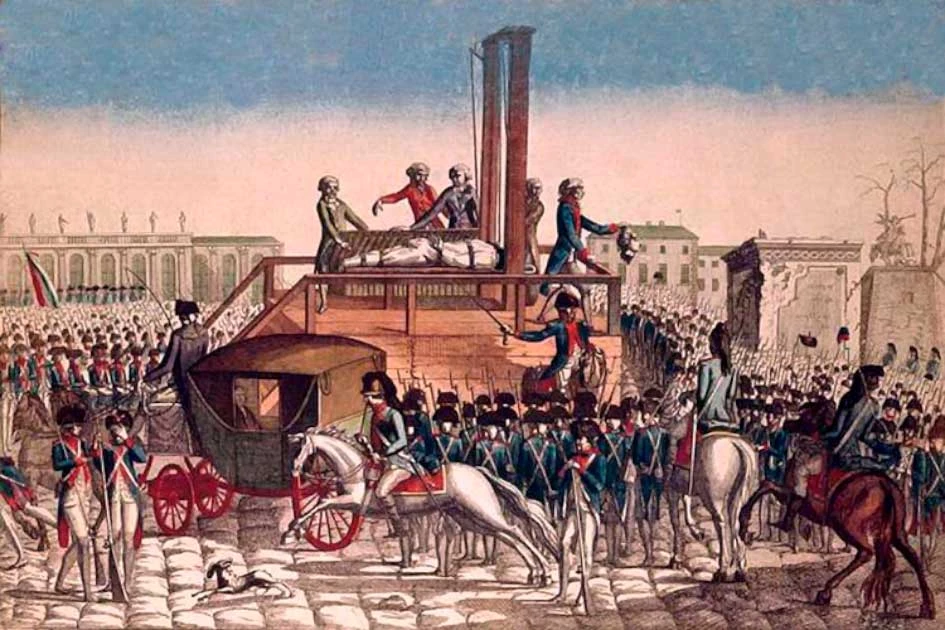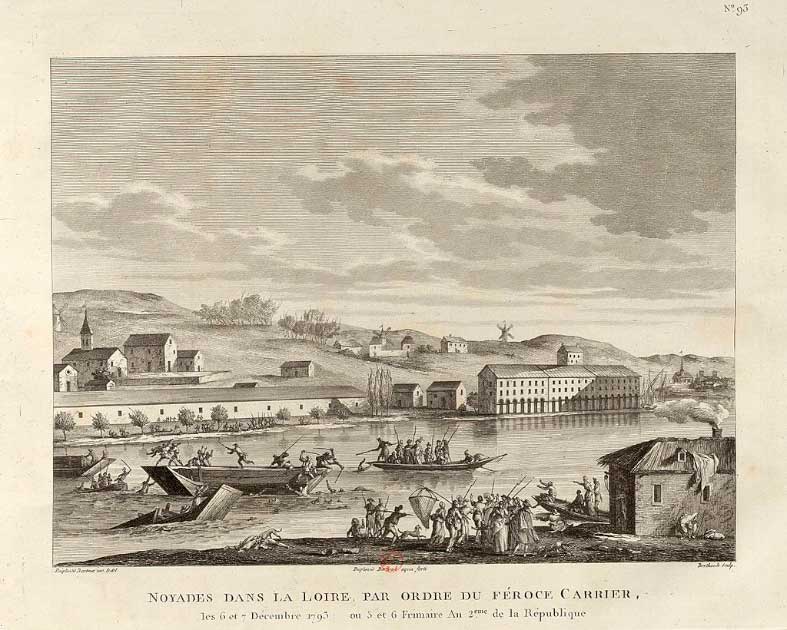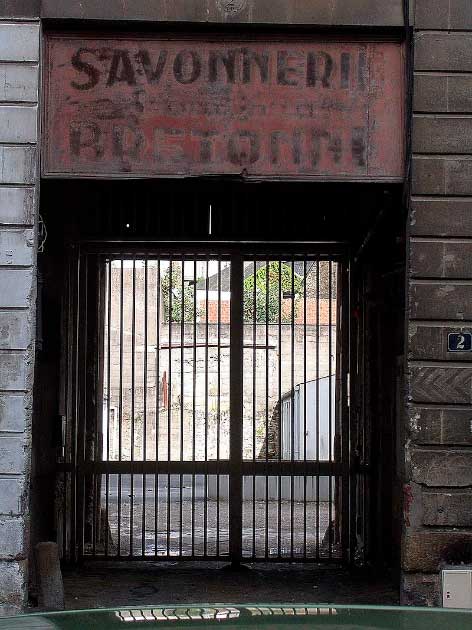The process of drowning is a terrible way to die. Once a person is fully submerged in the water, the process of drowning inexorably begins. The first stage is voluntary apnea (holding your breath) which is the natural reaction of the body in water. On average most people can hold their breath between 45 and 60 seconds.
If you are unable to get to the surface of the water in that time, your body and you will begin to panic. Your fear will grow as your carbon dioxide levels rise and your oxygen levels fall. You will suddenly experience an involuntary breath under the water, which will cause water to rush into your nose, mouth, and airway.
Death occurs after that final breath. There is a reason waterboarding is an illegal interrogation method; it is a terrifying and painful way to die.
During the French Revolution’s Reign of Terror, hundreds of thousands of people were killed or died in prison, even if they were not guilty of any crime. In the city of Nantes, one man ordered thousands of people to be drowned. His sick method for drowning the people of Nantes was known as republican marriages. These “marriages” were far from romantic or happy occasions.
The Reign of Terror
After the First Republic was created during the French Revolution, there was a period that was known as the Reign of Terror. While there is disagreement among historians about the start of the Reign of Terror, it largely refers to September 1793 to July 1794.

During the Reign of Terror, there were large-scale massacres and public executions due to revolutionary supporters and resisters, opposition to religious authority, and accusations of treason by the Committee of Public Safety (the de facto government during 1793 and 1794).
During this period it is estimated that at least 300,000 people were arrested and 17,000 were “officially” executed, but this number might be much higher. Another 10,000 people were estimated to have died in prison or were sentenced without going through a trial.
Often, these deaths were cruel and ruthless. The guillotine may have been introduced as a humane way of execution, but other methods employed were far more drawn out, and far nastier. Republican marriage or “mariage républicain” was one of these, a brutal form of execution that was said to have occurred in the city of Nantes, in the Loire-Atlantique on the Loire river of France.
A republican marriage was performed by tying a naked man and a naked woman together and then drowning them in the Loire river. These republican marriages paired the old with the old, children with children, priests with nuns, and let them sink to watery graves. And the responsibility for this terrible method of execution rests with one man, Jean-Baptiste Carrier.
Jean-Baptise Carrier
Jean-Baptise Carrier was a politician and French Revolutionary who was sent to Nantes in October 1793 as a représentant en mission (a representative on a mission). Carrier was sent to Nantes by the National Convention to put a stop to any anti-revolutionary behavior in the town.
- The Tavora Executions: An Entire Noble Family Put to the Sword
- The Tophet: Was Ancient Carthage Driven to Child Sacrifice?
He formed a tribunal in the city to “dispose quickly of the masses of prisoners heaped in prison.” After holding trials for a while, Carrier decided to be the judge, jury, and executioner by having people shot, sent to the guillotines, or “disposed of in another way.”

During the Reign of Terror in Nantes, anyone who did not fervently support the Revolution, Catholic priests and nuns, and anyone suspected or alleged to be a royalist sympathizer was arrested and sentenced to death. For Jean-Baptiste Carrier, his favorite method of execution was republican marriages.
The war in the Vendée (western France) was occurring in Loire-Atlantique at that time, which meant the city of Nantes was constantly on the edge of widespread epidemics like typhus and famine. Over ten thousand prisoners of war, along with the clergy, accused of or not being all about the Revolution were locked away in Nantes.
With so many people arrested, it became almost impossible and expensive to try to feed the people in the jails. Jean-Baptiste Carrier was sent to “control the situation.” Because contagious diseases like cholera and typhus began to spread from the staggering numbers of sick and dead prisoners to the town’s people, Carrier was told to do anything it took to stop the spread of diseases.
Drowning the ill and prisoners sounded like a great idea, and an estimated number of four thousand people or more died by drownings and republican marriages. Innocent people, families, women, children, and political prisoners were all sent to die in “the national bathtub,” as Carrier called the Loire river.
A Barbarous Act
Two French historians, Archibald Alison and Edward Sherman Gould described the practice of republican marriage as “two persons of different genders, generally an old man and old woman, or a young man and a young woman, bereft of every kind of clothing, were bound together before the multitude, exposed in a boat in that situation for half an hour or more, and then thrown into the river.”
Prisoners, including children and pregnant mothers, were put on a boat, known as a lighter, with a railing on it, so if someone managed to untie themselves, they couldn’t jump off the boat. The lighters were boats made for the drownings of the people in Nantes that had plugs made in the sides and bottoms of the ship at water level. The plugs were pulled out by Carrier’s men on separate boats or from shore, and the lighters would slowly sink into the river, drowning everyone on board.

It was common for these naked and bound people in the boat to be left waiting for their death and exposed to the elements. If they were lucky, they would be knocked unconscious with the butt end of a musket before the plugs were pulled.
Some legends state that when Carrier’s lead executioner dropped dead after watching a boat of crying and screaming children drown, Carrier himself was more than happy to take on the role of executioner. If this story is true or simply legend, Carrier most likely took part in the republican weddings or at least stood on the shore controlling the event.
At the beginning of these sick republican marriages, the event would be held at night in a poor effort to hide what was happening from other prisoners and the people of Nantes. However, Carrier decided that wasn’t good enough and ordered republican weddings to occur during the day.
- The Lost Dauphin: What Happened to Louis XVII?
- Prankster or Assassin? How Richard Roose Made Henry VIII Change the Law
This possibly could have been a way to deter anyone who wasn’t dying of disease or in prison from doing anything that would put them in jail. During the daylight republican marriages, some accounts tell of men standing on the shore would see a woman they liked after she was stripped and would rape them before killing them. Carrier was said to have done this as well, making drowning seem like a kinder way to be killed.
The End of Republican Marriages
Carrier left Nantes when he was called to be at the trial of Robespierre, a controversial and powerful player in the French Revolution in 1794. People at the trial began to accuse Carrier of the drownings in Nantes.
He was arrested in Paris on September 3, 1794, and at his trial, Carrier claimed he knew nothing about what he was being accused of. Carrier was charged with thefts, acts of greed, thefts, butchering women and children, executions, and drownings. On December 16, 1794, Carrier was executed by guillotine, a kinder end than he offered his victims.

There is no denying that Carrier ordered the drownings of thousands of people in Nantes on lighter boats. What is subject to debate is if republican marriages actually happened. It wasn’t until the trial of Jean-Baptiste Carrier that stories of republican marriages emerged.
Several historians of the French Revolution believe republican marriages to be a legend and only imagined for trial to damn Carrier even more, which wasn’t necessary. The fact that Carrier drowned people was enough to have him executed.
Republican marriages were mentioned in several witness testimonies and letters, however they all admitted that they had only heard of republican marriages, not seen them occur. Records from the trial include statements by the defense and the prosecutor noting that there was zero evidence to support the accusations of republican marriages and it was ignored by the jury.
Later the rumors of republican marriages became so significant that many books and articles about the Reign of Terror go into great detail to describe the act and it is considered exaggeration of authors when claims that a nun and a priest were victims arise.
Can we definitely say that republican marriages happened? No, but we can be sure that Carrier drowned many people in Nantes. It is unknown if the victims were nude, paired in couples or were tied together on the lighter boats.
It is possible that victims were tied to each other or the boat to ensure they couldn’t swim once in the water. One look at the Spanish Inquisition and its methods of torture proves that humans can create brutal ways of executing people. Real or not, it sounds like a horrible way to die.
Top Image: Republican Marriage: the drownings at Nantes. Source: Unknown Author / CC BY-SA 4.0.
By Lauren Dillon